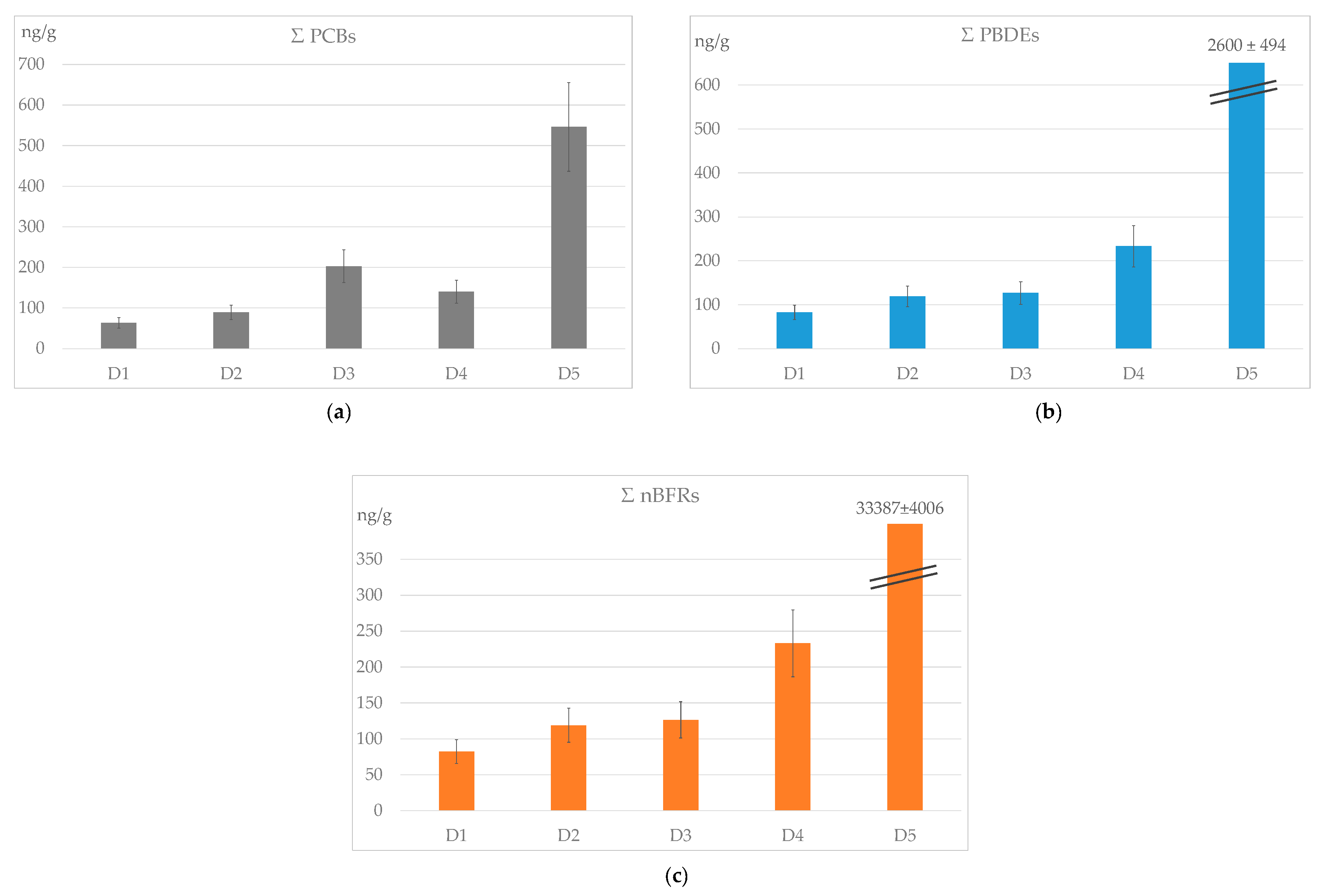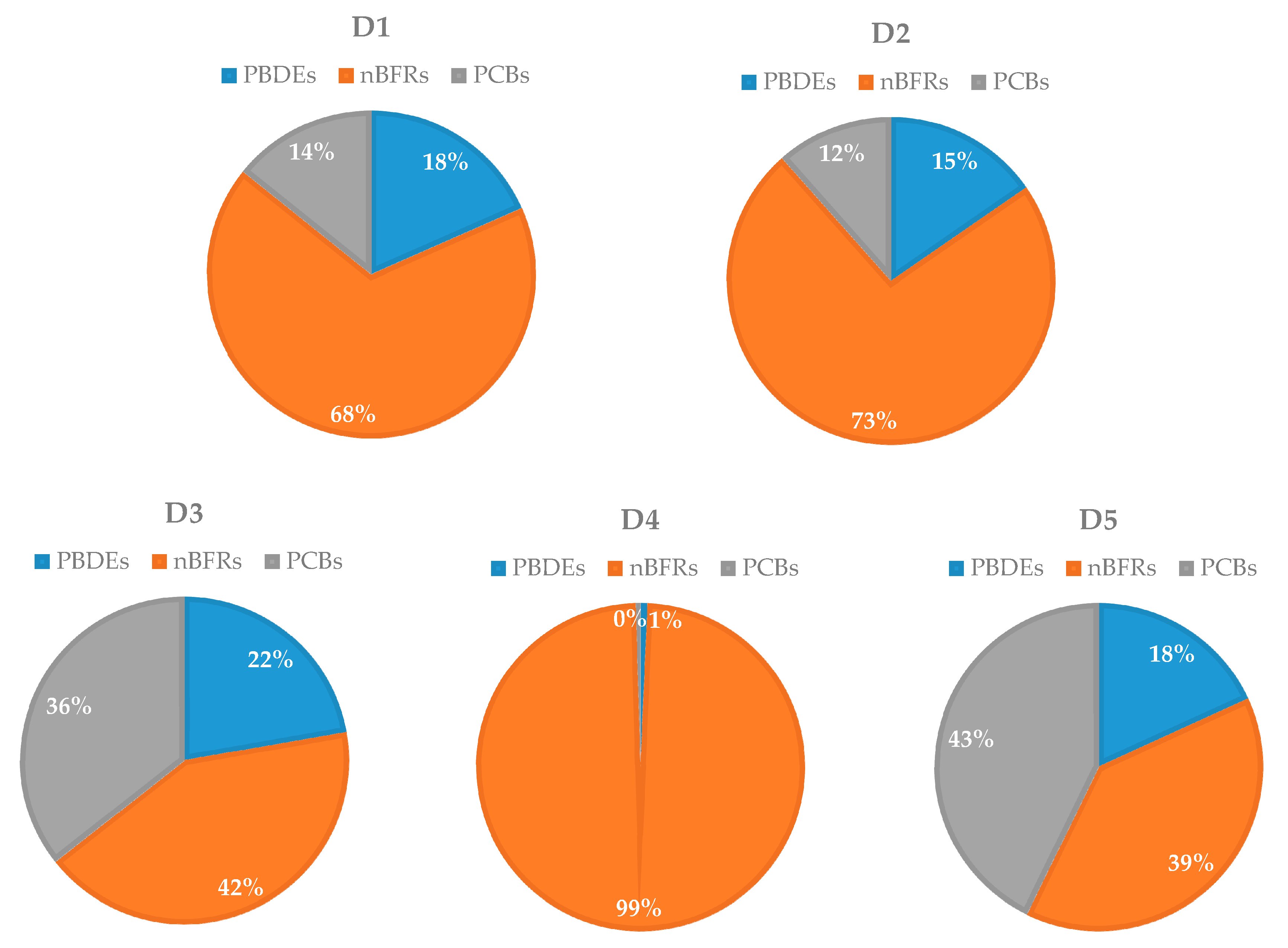Emerging and Legacy Organic Halogenated Pollutants in Indoor Dusts †
Abstract
:1. Introduction
2. Methods
3. Results and Discussion
4. Conclusions
Funding
Conflicts of Interest
References
- Taheran, M.; Komtchou, S.; Lonappan, L.; Naji, T.; Brar, S.K.; Cledon, M. Technology Environmental issues of Polybrominated Diphenyl Ethers. Crit. Rev. Environ. Sci. Technol. 2017, 47, 1107–1142. [Google Scholar] [CrossRef]
- UNEP. Listing of tetrabromodiphenyl ether and pentabromodiphenyl ether. In Proceedings of the Fourth Meeting of the Conference of the Parties to the Stockholm Convention, Geneva, Switzerland, 4–8 May 2009. SC-4/18. [Google Scholar]
- UNEP. Listing of hexabromodiphenyl ether and heptabromodiphenyl ether. In Proceedings of the Fourth Meeting of the Conference of the Parties to the Stockholm Convention, Geneva, Switzerland, 4–8 May 2009. SC-4/14. [Google Scholar]
- International Programme on Chemical Safety. Environmental Health Criteria 172. Tetrabromobisphenol A and Derivatives; World Health Organization: Geneva, Switzerland, 1995. [Google Scholar]
- Khalaf, H.; Larsson, A.; Berg, H.; McCrindle, R.; Arsenault, G.; Olsson, P.-E. Diastereomers of the Brominated Flame Retardant 1,2-Dibromo-4-(1,2 dibromoethyl)cyclohexane Induce Androgen Receptor Activation in the HepG2 Hepatocellular Carcinoma Cell Line and the LNCaP Prostate Cancer Cell Line. Environ. Health Perspect. 2009, 117, 1853–1859. [Google Scholar] [CrossRef] [PubMed]
- Melzer, D.; Rice, N.; Depledge, M.H.; Henley, W.E.; Galloway, T.S. Association between Serum Perfluorooctanoic Acid (PFOA) and Thyroid Disease in the U.S. National Health and Nutrition Examination Survey. Environ. Health Perspect. 2010, 118, 686–692. [Google Scholar] [CrossRef] [PubMed]
- Darrow, L.A.; Groth, A.C.; Winquist, A.; Shin, H.-M.; Bartell, S.; Steenland, K. Modeled Perfluorooctanoic Acid (PFOA) Exposure and Liver Function in a Mid-Ohio Valley Community. Environ. Health Perspect. 2016, 124, 1227–1233. [Google Scholar] [CrossRef] [PubMed]
- Fitz-Simon, N.; Fletcher, T.; Luster, M.I.; Steenland, K.; Calafat, A.M.; Kato, K.; Armstrong, B. Reductions in serum lipids with a 4-year decline in serum perfluorooctanoic acid and perfluorooctanesulfonic acid. Epidemiology 2013, 24, 569–576. [Google Scholar] [CrossRef] [PubMed]
- Stubbings, W.A.; Harrad, S. Extent and mechanisms of brominated fl ame retardant emissions from waste soft furnishings and fabrics: A critical review. Environ. Int. 2014, 71, 164–175. [Google Scholar] [CrossRef] [PubMed]
- Buiarelli, F.; Di Filippo, P.; Pomata, D.; Riccardi, C.; Bartocci, M. A liquid chromatography tandem mass spectrometry method for simultaneous analysis of 46 atmospheric particulate-phase persistent organic pollutants and comparison with gas chromatography/mass spectrometry. Int. J. Environ. Anal. Chem. 2017, 97, 1–22. [Google Scholar] [CrossRef]
- Pomata, D.; Di Filippo, P.; Riccardi, C.; Rossi, V.; Simonetti, G.; Sonego, E.; Buiarelli, F. Method optimisation for the simultaneous determination of legacy and emerging halogenated flame retardants in particulate matter collected in an electronic waste recycling facility. Int. J. Environ. Anal. Chem. 2019. [Google Scholar] [CrossRef]
- Iwegbue, C.M.A.; Eyengho, S.B.; Egobueze, F.E.; Odali, E.W.; Tesi, G.O.; Nwajei, G.E.; Martincigh, B.S. Polybrominated diphenyl ethers and polychlorinated biphenyls in indoor dust from electronic repair workshops in southern Nigeria: Implications for onsite human exposure. Sci. Total Environ. 2019, 671, 914–927. [Google Scholar] [CrossRef]
- Rudel, R.A.; Seryak, L.M.; Brody, J.G. PCB-containing wood floor finish is a likely source of elevated PCBs in residents’ blood, household air and dust: A case study of exposure. Environ. Health 2008, 7, 2. [Google Scholar] [CrossRef] [PubMed]
- Wang, J.; Wang, Y.; Shi, Z.; Zhou, X.; Sun, Z. Legacy and novel brominated fl ame retardants in indoor dust from Beijing, China: Occurrence, human exposure assessment and evidence for PBDEs replacement. Sci. Total Environ. 2018, 618, 48–59. [Google Scholar] [CrossRef] [PubMed]
- Venier, M.; Vojta, Š.; Be, J.; Romanak, K.; Melymuk, L.; Krátká, M.; Kuku, P.; Okeme, J.; Saini, A.; Diamond, M.L.; et al. Brominated flame retardants in the indoor environment—Comparative study of indoor contamination from three countries. Environ. Int. 2016, 94, 150–160. [Google Scholar] [CrossRef] [PubMed]
- Wemken, N.; Drage, D.S.; Abdallah, M.A.-E.; Harrad, S.; Coggins, M.A.; Coggins, A.M. Concentrations of Brominated Flame Retardants in Indoor Air and Dust from Ireland Reveal Elevated Exposure to Decabromodiphenyl Ethane. Environ. Sci. Technol. 2019, 53, 9826–9836. [Google Scholar] [CrossRef] [PubMed]
- Sjödin, A.; Carlsson, H.; Thuresson, K.; Sjölin, S.; Bergman, Å.; Östman, C. Flame retardants in indoor air at an electronics recycling plant and at other work environments. Environ. Sci. Technol. 2001, 35, 448–454. [Google Scholar] [CrossRef] [PubMed]
- Abafe, O.A.; Martincigh, B. Determination and human exposure assessment of polybrominated diphenyl ethers and tetrabromobisphenol A in indoor dust in South Africa. Environ. Sci. Pollut. Res. 2016, 23, 7038–7049. [Google Scholar] [CrossRef] [PubMed]


Publisher’s Note: MDPI stays neutral with regard to jurisdictional claims in published maps and institutional affiliations. |
© 2019 by the authors. Licensee MDPI, Basel, Switzerland. This article is an open access article distributed under the terms and conditions of the Creative Commons Attribution (CC BY) license (https://creativecommons.org/licenses/by/4.0/).
Share and Cite
Simonetti, G.; Sonego, E.; Castellani, F.; Filippo, P.D.; Riccardi, C.; Pomata, D.; Buiarelli, F. Emerging and Legacy Organic Halogenated Pollutants in Indoor Dusts. Proceedings 2020, 44, 3. https://doi.org/10.3390/IECEHS-2-06391
Simonetti G, Sonego E, Castellani F, Filippo PD, Riccardi C, Pomata D, Buiarelli F. Emerging and Legacy Organic Halogenated Pollutants in Indoor Dusts. Proceedings. 2020; 44(1):3. https://doi.org/10.3390/IECEHS-2-06391
Chicago/Turabian StyleSimonetti, Giulia, Elisa Sonego, Federica Castellani, Patrizia Di Filippo, Carmela Riccardi, Donatella Pomata, and Francesca Buiarelli. 2020. "Emerging and Legacy Organic Halogenated Pollutants in Indoor Dusts" Proceedings 44, no. 1: 3. https://doi.org/10.3390/IECEHS-2-06391
APA StyleSimonetti, G., Sonego, E., Castellani, F., Filippo, P. D., Riccardi, C., Pomata, D., & Buiarelli, F. (2020). Emerging and Legacy Organic Halogenated Pollutants in Indoor Dusts. Proceedings, 44(1), 3. https://doi.org/10.3390/IECEHS-2-06391






